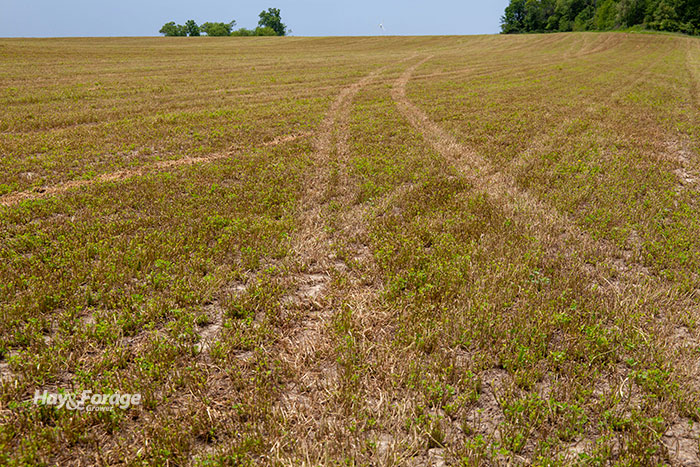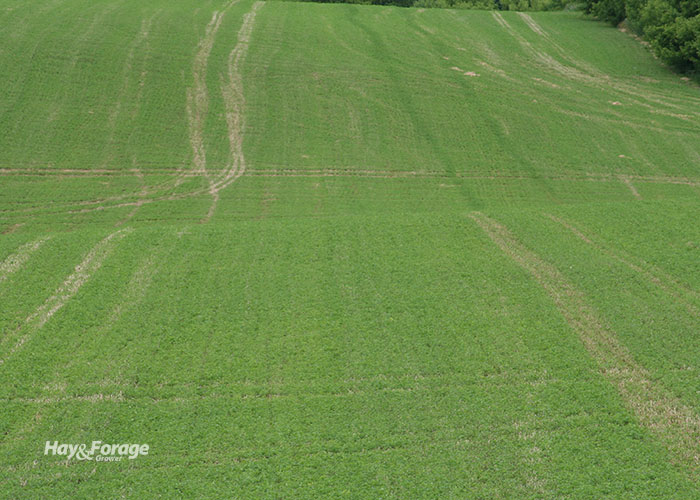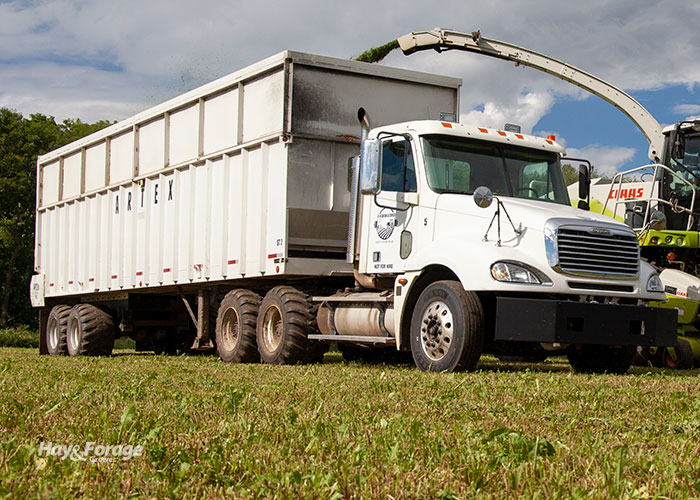A 30-ton alfalfa pest |
| By Mike Rankin, Managing Editor |
|
|
 The problem is easy to identify, and so are the plant symptoms. The answers are often less apparent. There’s no need for a magnifying glass to see that large equipment, driving across alfalfa fields during harvest, is taking its toll on the nation’s alfalfa crop, especially when fields are near field capacity moisture. We all know this to be true, but figuring out a solution when forage harvesters increasingly deliver more tons per hour to the silage pile is not so easy. Brian Luck, an extension ag engineer at the University of Wisconsin-Madison, is on a mission to study and hopefully offer solutions to minimize the issue. He reported some of his initial results during one of the virtual Dairy-Forage Seminars held in conjunction with the World Forage Analysis Superbowl. Luck pointed out that there are several variables impacting the footprint of harvesting equipment. Of course, gross weight is the most obvious. He showed a chart with average weight ranges for various types of equipment. These ranged from 12,500 pounds for the mower to 53,000 pounds for an empty semitruck and trailer. “As we look at these machines, we might begin to think that some of these are getting too heavy,” Luck said. “However, we have to remember that there is a big difference between road tires and agricultural tires in terms of the footprint.”  Wheel track damage from semitrucks and trailers (in this case) are visible well into the alfalfa regrowth cycle. Most of the equipment used to harvest forage will leave a footprint in the range of 100 to a little over 200 pounds per square inch (psi), according to Luck. Box (straight) trucks and semitrucks/trailers will fall more in the range of 500 to over 800 psi if operated with highway tires. “If a soil is at field capacity moisture, you’ll likely be causing a significant amount of compaction in those truck tire tracks,” Luck noted. In addition to weight and tire type, tire pressure also has a significant influence on the pressure applied to the soil surface. “It’s really important to make sure tires are not overinflated when harvesting forage,” Luck emphasized. “For every 1-pound increase in tire pressure, it can add 5 to over 8 pounds to the psi of the footprint.” A final factor involved in wheel traffic alfalfa damage is timing. The more time that passes between cutting and running over fields elevates the chance for plant damage. This is mostly the result of breaking off new regrowth stems. Looking for answers Luck is currently involved in a research study evaluating the impact of wheel traffic effects on alfalfa. His research team is measuring soil compaction, effects on alfalfa yield and quality, and is looking for ways to possibly predict and prevent these losses. Timing of wheel traffic following harvest is also being evaluated. In short, he’s looking for some answers and solutions. The research is being done on a 2019-seeded field and on an established alfalfa stand at the Arlington Ag Research Station, which is located in south-central Wisconsin. For the seeded field, three different tillage protocols were imposed (heavy, medium, and no-till). A 17,000-pound self-propelled mower is being used to apply compaction, and there are seven different treatments varying in the number and timing of wheel-track passes. The initial results of the trial are showing some substantial dry matter yield losses in the order of 0.5 tons per acre per year compared to the zero-compaction control. Luck mentioned that there are also some obvious visible impacts on plant height and maturity. As for soil compaction, the results were as expected. Compaction increased according to the number of trips across the treatment plot area. Luck is also using unmanned aerial vehicles, or drones, to acquire normalized difference vegetation index (NDVI) imagery of the plots. It’s hoped that the digital photos will aid in the development of a model that will predict the impacts of wheel traffic damage on alfalfa yield and quality. Moving forward, Luck plans to continue the current study. He also wants to determine the percentage of an alfalfa field that actually is affected by wheel traffic following one or a year’s worth of harvests. Finally, he wants to investigate how different tire types might help to alleviate some of the damage being done by harvest equipment. Farmers know Luck is documenting what most farmers and custom forage harvesters intuitively know and see. Field traffic has a profound impact on alfalfa growth and yield. Without question, topping the list of yield-robbing culprits are the semitrucks and trailers whose damage is readily visible.  Replacing standard dual highway tires with agricultural tires can help reduce the impact on alfalfa regrowth and subsequent production. Finally, we are also seeing more farmers pay attention to consolidating wheel traffic within a field. In some cases, truck traffic is being limited to headlands and field edges with no U-turns allowed in the middle of fields.
|
